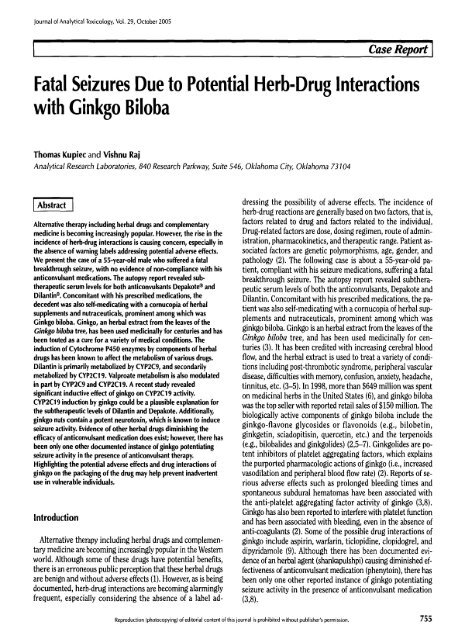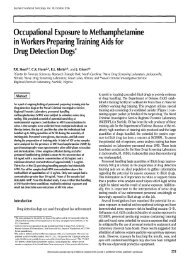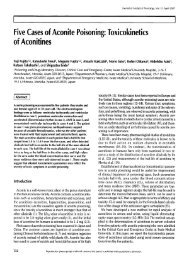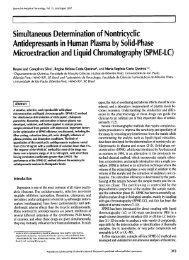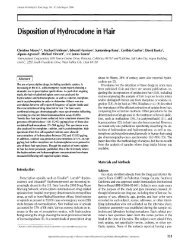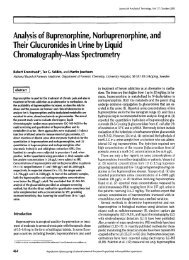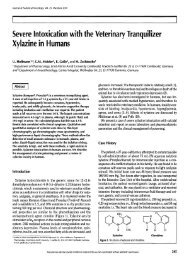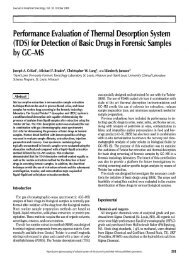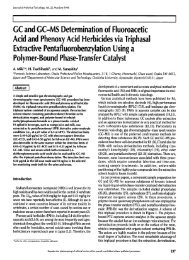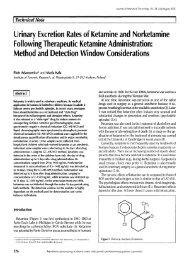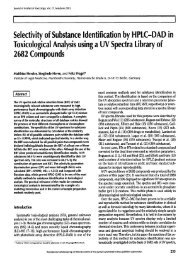Fatal Seizures Due to Potential Herb-Drug Interactions - Journal of ...
Fatal Seizures Due to Potential Herb-Drug Interactions - Journal of ...
Fatal Seizures Due to Potential Herb-Drug Interactions - Journal of ...
You also want an ePaper? Increase the reach of your titles
YUMPU automatically turns print PDFs into web optimized ePapers that Google loves.
<strong>Journal</strong> <strong>of</strong> Analytical Toxicology, Vol. 29, Oc<strong>to</strong>ber 2005<br />
] Case Report [<br />
<strong>Fatal</strong> <strong>Seizures</strong> <strong>Due</strong> <strong>to</strong> <strong>Potential</strong> <strong>Herb</strong>-<strong>Drug</strong> <strong>Interactions</strong><br />
with Ginkgo Biloba<br />
Thomas Kupiec and Vishnu Raj<br />
Analytical Research Labora<strong>to</strong>ries, 840 Research Parkway, Suite 546, Oklahoma City, Oklahoma 73104<br />
Abstract[<br />
Alternative therapy including herbal drugs and complementary<br />
medicine is becoming increasingly popular. However, the rise in the<br />
incidence <strong>of</strong> herb-drug interactions is causing concern, especially in<br />
the absence <strong>of</strong> warning labels addressing potential adverse effects.<br />
We present the case <strong>of</strong> a 55-year-old male who suffered a fatal<br />
breakthrough seizure, with no evidence <strong>of</strong> non-compliance with his<br />
anticonvulsant medications. The au<strong>to</strong>psy report revealed sub-<br />
therapeutic serum levels for both anticonvulsants Depakote | and<br />
Dilantin | . Concomitant with his prescribed medications, the<br />
decedent was also self-medicating with a cornucopia <strong>of</strong> herbal<br />
supplements and nutraceuticals, prominent among which was<br />
Ginkgo biloba. Ginkgo, an herbal extract from the leaves <strong>of</strong> the<br />
Ginkgo biloba tree, has been used medicinally for centuries and has<br />
been <strong>to</strong>uted as a cure for a variety <strong>of</strong> medical conditions. The<br />
induction <strong>of</strong> Cy<strong>to</strong>chrome P450 enzymes by components <strong>of</strong> herbal<br />
drugs has been known <strong>to</strong> affect the metabolism <strong>of</strong> various drugs.<br />
Dilantin is primarily metabolized by CYP2C9, and secondarily<br />
metabolized by CYP2C19. Valproate metabolism is also modulated<br />
in part by CYP2C9 and CYP2C19. A recent study revealed<br />
significant inductive effect <strong>of</strong> ginkgo on CYP2C19 activity.<br />
CYP2C19 induction by ginkgo could be a plausible explanation for<br />
the subtherapeutic levels <strong>of</strong> Dilantin and Depakote. Additionally,<br />
ginkgo nuts contain a potent neuro<strong>to</strong>xin, which is known <strong>to</strong> induce<br />
seizure activity. Evidence <strong>of</strong> other herbal drugs diminishing the<br />
efficacy <strong>of</strong> anticonvulsant medication does exist; however, there has<br />
been only one other documented instance <strong>of</strong> ginkgo potentiating<br />
seizure activity in the presence <strong>of</strong> anticonvulsant therapy.<br />
Highlighting the potential adverse effects and drug interactions <strong>of</strong><br />
ginkgo on the packaging <strong>of</strong> the drug may help prevent inadvertent<br />
use in vulnerable individuals.<br />
Introduction<br />
Alternative therapy including herbal drugs and complemen-<br />
tary medicine are becoming increasingly popular in the Western<br />
world. Although some <strong>of</strong> these drugs have potential benefits,<br />
there is an erroneous public perception that these herbal drugs<br />
are benign and without adverse effects (1). However, as is being<br />
documented, herb-drug interactions are becoming alarmingly<br />
frequent, especially considering the absence <strong>of</strong> a label ad-<br />
dressing the possibility <strong>of</strong> adverse effects. The incidence <strong>of</strong><br />
herb-drug reactions are generally based on two fac<strong>to</strong>rs, that is,<br />
fac<strong>to</strong>rs related <strong>to</strong> drug and fac<strong>to</strong>rs related <strong>to</strong> the individual.<br />
<strong>Drug</strong>-related fac<strong>to</strong>rs are dose, dosing regimen, route <strong>of</strong> admin-<br />
istration, pharmacokinetics, and therapeutic range. Patient as-<br />
sociated fac<strong>to</strong>rs are genetic polymorphisms, age, gender, and<br />
pathology (2). The following case is about a 55-year-old pa-<br />
tient, compliant with his seizure medications, suffering a fatal<br />
breakthrough seizure. The au<strong>to</strong>psy report revealed subthera-<br />
peutic serum levels <strong>of</strong> both the anticonvulsants, Depakote and<br />
Dilantin. Concomitant with his prescribed medications, the pa-<br />
tient was also self-medicating with a cornucopia <strong>of</strong> herbal sup-<br />
plements and nutraceuticals, prominent among which was<br />
ginkgo biloba. Ginkgo is an herbal extract from the leaves <strong>of</strong> the<br />
Ginkgo biloba tree, and has been used medicinally for cen-<br />
turies (3). It has been credited with increasing cerebral blood<br />
flow, and the herbal extract is used <strong>to</strong> treat a variety <strong>of</strong> condi-<br />
tions including post4hrombotic syndrome, peripheral vascular<br />
disease, difficulties with memory, confusion, anxiety, headache,<br />
tinnitus, etc. (3-5). In 1998, more than $649 million was spent<br />
on medicinal herbs in the United States (6), and ginkgo biloba<br />
was the <strong>to</strong>p seller with reported retail sales <strong>of</strong> $150 million. The<br />
biologically active components <strong>of</strong> ginkgo biloba include the<br />
ginkgo-flavone glycosides or flavonoids (e.g., bilobetin,<br />
ginkgetin, sciadopitisin, quercetin, etc.) and the terpenoids<br />
(e.g., bilobalides and ginkgolides) (2,5-7). Ginkgolides are po-<br />
tent inhibi<strong>to</strong>rs <strong>of</strong> platelet aggregating fac<strong>to</strong>rs, which explains<br />
the purported pharmacologic actions <strong>of</strong> ginkgo (i.e., increased<br />
vasodilation and peripheral blood flow rate) (2). Reports <strong>of</strong> se-<br />
rious adverse effects such as prolonged bleeding times and<br />
spontaneous subdural hema<strong>to</strong>mas have been associated with<br />
the anti-platelet aggregating fac<strong>to</strong>r activity <strong>of</strong> ginkgo (3,8).<br />
Ginkgo has also been reported <strong>to</strong> interfere with platelet function<br />
and has been associated with bleeding, even in the absence <strong>of</strong><br />
anti-coagulants (2). Some <strong>of</strong> the possible drug interactions <strong>of</strong><br />
ginkgo include aspirin, warfarin, ticlopidine, clopidogrel, and<br />
dipyridamole (9). Although there has been documented evi-<br />
dence <strong>of</strong> an herbal agent (shankapulshpi) causing diminished ef-<br />
fectiveness <strong>of</strong> anticonvulsant medication (pheny<strong>to</strong>in), there has<br />
been only one other reported instance <strong>of</strong> ginkgo potentiating<br />
seizure activity in the presence <strong>of</strong> anticonvulsant medication<br />
(3,8).<br />
Reproduction (pho<strong>to</strong>copying) <strong>of</strong> edi<strong>to</strong>rial content <strong>of</strong> this journal is prohibited without publisher's permission. 755
Case His<strong>to</strong>ry<br />
The decedent, a 55-year-old male, was swimming at a health<br />
club with an attendant walking alongside as he swam, when he<br />
suddenly went underwater and lost consciousness. The two life-<br />
guards at the pool immediately pulled him out, and one <strong>of</strong> them<br />
initiated CPR; paramedics were summoned. There was an initial<br />
report <strong>of</strong> a seizure in the pool, but it could not be corrobo-<br />
rated. During the time that the paramedics attempted resusci-<br />
tation, they encountered a pulseless rhythm, ventricular fibril-<br />
lations, and ventricular tachycardia. The patient received<br />
defibrillation and intravenous advanced cardiac life support<br />
medications including epinephrine, bicarbonate, and normal<br />
saline. At the ER, he was observed <strong>to</strong> be lifeless and cyanotic,<br />
with an absence <strong>of</strong> spontaneous movements or respirations.<br />
Pulmonary sounds were symmetric, with bilateral coarse rales<br />
and rhonchi. The pupils were fixed and dilated with an absence<br />
<strong>of</strong> corneal and doll's eye reflexes. The nail beds were cyanotic,<br />
and the patient was flaccid with an absence <strong>of</strong> neurological re-<br />
sponses. The patient was pronounced dead, and an au<strong>to</strong>psy was<br />
indicated. Au<strong>to</strong>psy results revealed evidence <strong>of</strong> an old cerebral<br />
infarct and severe coronary vascular disease, as well as an old<br />
myocardial infarct and prior bypass surgery. The <strong>to</strong>xicological<br />
analyses involved a broad-based gas chroma<strong>to</strong>graphy (GC)<br />
screen for acidic/neutral drugs, with confirmation by GC-mass<br />
spectroscopy (MS). Trinders' test was used <strong>to</strong> check for salicy-<br />
lates, and headspace GC was used for analysis <strong>of</strong> volatiles. Chem-<br />
Elut columns were used for GC. The <strong>to</strong>xicological analysis re-<br />
vealed a femoral blood valproic acid (Depakote) level <strong>of</strong> less<br />
than 26 IJg/mL and a pheny<strong>to</strong>in (Dilantin) level <strong>of</strong> 2.5 IJg/mL.<br />
Caprillic acid and para-methyl pheny<strong>to</strong>in were used as internal<br />
standards for valproic acid and pheny<strong>to</strong>in, respectively. Both<br />
the anti-epileptic drugs were considered <strong>to</strong> be subtherapeutic at<br />
these levels. The cause <strong>of</strong> death was ruled <strong>to</strong> be a seizure disorder<br />
due <strong>to</strong> an old cerebrovascular event. According <strong>to</strong> his medical<br />
records, the patient had been in sound health until a year prior<br />
<strong>to</strong> his demise, when he experienced a cerebrovascular accident<br />
following coronary artery bypass surgery, after which he devel-<br />
oped a seizure disorder. His medical records revealed that, on<br />
three occasions, his anticonvulsant (Dilantin, Depakote) serum<br />
drug levels had dipped below the therapeutic range for no ap-<br />
parent reason. Table I provides serum Dilantin levels from the<br />
medical records <strong>of</strong> the deceased. On one occasion, he experi-<br />
Table I. Fluctuations in the Dilantin Levels<br />
Date Dilantin Level Therapeutic Range<br />
4/24/00 4.1 mg/L<br />
5/3/00 10.4 mg/L<br />
7/21/00 14.0 mg/L<br />
8/4/00 9.6 mg/L<br />
8/14/00 10.6 mg/L<br />
8/25/00 13.7 mg/L<br />
9/29/00 21.2 mg/L<br />
10/20/00 14.1 mg/L<br />
11/30/00 13.9 mg/L<br />
756<br />
10 <strong>to</strong> 20 mg/L<br />
<strong>Journal</strong> <strong>of</strong> Analytical Toxicology, Vol. 29, Oc<strong>to</strong>ber 2005<br />
enced a breakthrough seizure with a therapeutic Dilantin<br />
level. Following his demise, it was discovered that apart from<br />
his prescription medications, the deceased was taking copious<br />
nonprescription vitamins, supplements, and herbal nutraceuti-<br />
cals, apparently without the knowledge <strong>of</strong> his physician. He<br />
had begun taking the supplements approximately a year prior<br />
<strong>to</strong> his death. The most common herbal ingredient in these<br />
preparations was ginkgo, an extract from the leaves <strong>of</strong> the<br />
Ginkgo biloba tree. Among the other ingredients were ginseng<br />
and saw palmet<strong>to</strong> extracts. The possible seizure-potentiating<br />
role <strong>of</strong> these herbal products was explored in an extensive liter-<br />
ature study.<br />
Discussion<br />
<strong>Herb</strong>al products have long been popular, and some <strong>of</strong> their<br />
modern derivatives constitute highly prescribed medications<br />
(e.g., the evolution <strong>of</strong> digoxin from foxglove). Although many<br />
herbs have been evaluated in randomized controlled trials, the<br />
limitations <strong>of</strong> poor design, small samples, and uncertain com-<br />
position <strong>of</strong> products make any reliable interpretation impossible.<br />
Furthermore, the absence <strong>of</strong> advisory warning labels addressing<br />
possible adverse effects <strong>of</strong> these nutraceutical agents, make it<br />
imperative <strong>to</strong> study and document any possible drug interac-<br />
tions. The U.S. Food and <strong>Drug</strong> Administration's Special Nutri-<br />
tionals Adverse Effect Moni<strong>to</strong>ring System (SN/AEMS) described<br />
seven reports <strong>of</strong> seizures associated with ginkgo. Four reports<br />
were associated with multi-ingredient products and three were<br />
associated with single-ingredient preparations, each from dif-<br />
ferent manufacturers (10). Several reports in the literature in-<br />
dicate that consumption <strong>of</strong> ginkgo nuts might induce seizure ac-<br />
tivity. After the consumption <strong>of</strong> ginkgo nuts, a previously healthy<br />
36-year-old woman without any past or family his<strong>to</strong>ry <strong>of</strong> epilepsy<br />
developed vomiting and generalized <strong>to</strong>nic and clonic convul-<br />
sions (11). Ginkgo nuts contain a potent neuro<strong>to</strong>xin, 4'-0-<br />
methoxypyridoxine (4'-MPN), which is known <strong>to</strong> indirectly in-<br />
hibit the enzyme activity <strong>of</strong> glutamate decarboxylase, resulting<br />
in decreased levels <strong>of</strong> y-amino-butyric acid (GABA)(12). GABA<br />
is an inhibi<strong>to</strong>ry neurotransmitter, and a reduced concentration<br />
<strong>of</strong> GABA may lead <strong>to</strong> seizure induction (11). The leaves <strong>of</strong> the<br />
ginkgo tree are a source <strong>of</strong> extracts for commercial ginkgo<br />
products. Although the majority <strong>of</strong> commercial ginkgo products<br />
may not contain sufficient 4'-MPN <strong>to</strong> cause seizures, depending<br />
on the harvest season and the potential introduction <strong>of</strong> con-<br />
taminants, 4'-MPN may be present in amounts sufficient <strong>to</strong><br />
cause seizures in a vulnerable populace, such as infants or in-<br />
dividuals with known seizure disorders (13). Arenz et al. (14)<br />
documented the occurrence <strong>of</strong> 4'-MPN in ginkgo leaves and<br />
some commercially available ginkgo preparations. Manocha et<br />
al. (15,16) proposed an alternative mechanism for the putative<br />
seizure activity <strong>of</strong> ginkgo biloba~ They found that ginkgo, a<br />
platelet-aggregating fac<strong>to</strong>r (PAF) antagonist, facilitated strych-<br />
nine-induced convulsions in mice. This study emphasized the<br />
possible modulating effect <strong>of</strong> ginkgo biloba on the inhibi<strong>to</strong>ry<br />
neurotransmitter glycine because strychnine competes with<br />
glycine, thus exerting a central stimulant effect through in-
<strong>Journal</strong> <strong>of</strong> Analytical Toxicology, Vol. 29, Oc<strong>to</strong>ber 2005<br />
hibi<strong>to</strong>ry blockade (15,16). Additionally, the prior administration<br />
<strong>of</strong> ginkgo <strong>to</strong> mice potentiated the seizure activity <strong>of</strong> picro<strong>to</strong>xin,<br />
a GABA antagonist, in the presence <strong>of</strong> the anti-convulsant drugs<br />
sodium valproate and carbamazepine. This was possibly be-<br />
cause <strong>of</strong> the anti-GABAergic activity <strong>of</strong> ginkgo components<br />
(15,16).<br />
Another putative hypothesis in the current case was the<br />
induction <strong>of</strong> the Cy<strong>to</strong>chrome P450 (GYP) enzyme system by<br />
nutraceutical ingredients, causing extensive metabolism <strong>of</strong><br />
the anticonvulsant mediations, thus leading <strong>to</strong> seizure induc-<br />
tion due <strong>to</strong> the subtherapeutic levels <strong>of</strong> these drugs. Zhou<br />
et al. (2) describe the induction and inhibition <strong>of</strong> CYP enzyme<br />
system by various components <strong>of</strong> herbal drugs. If the CYP<br />
enzymes metabolizing a certain drug are induced, they<br />
will hasten its elimination from circulation, thereby dimin-<br />
ishing its therapeutic benefit (17). Dilantin is primarily metab-<br />
olized by CYP2C9 and secondarily metabolized by CYP2C19<br />
(18). Additionally, valproate is also metabolized by CYP2C9<br />
and CYP2C19; however, these enzymes account for a relatively<br />
minor portion <strong>of</strong> its excretion (19). A recent study by Yin<br />
et al. (20) found significant inductive effect <strong>of</strong> ginkgo on<br />
CYP2C19 activity. They concluded that co-administration <strong>of</strong><br />
ginkgo with a CYP2C19 substrate may significantly reduce<br />
the effect <strong>of</strong> the drug. CYP2C19 induction by ginkgo could be<br />
a plausible explanation for the subtherapeutic levels <strong>of</strong><br />
Dilantin and Depakote.<br />
Granger (1), in what is probably the only other documented<br />
case <strong>of</strong> ginkgo precipitating seizure activity in the presence <strong>of</strong><br />
anticonvulsant medications, describes two patients with well-<br />
controlled epilepsy, compliant with their anti-epileptic medi-<br />
cation (sodium valproate), who developed seizures within two<br />
weeks <strong>of</strong> using ginkgo products. After cessation <strong>of</strong> the herbal<br />
remedy, both the patients remained seizure-free without any in-<br />
crease in the dosage <strong>of</strong> antiepileptic medication (1). Other re-<br />
ports <strong>of</strong> ginkgo include an elderly female with elevated blood<br />
pressure who was treated with a thiazide diuretic and later<br />
began taking ginkgo biloba. After one week, her blood pressure<br />
increased further and remained increased for a few weeks. After<br />
s<strong>to</strong>pping ginkgo and the diuretic, blood pressure returned <strong>to</strong><br />
pretreatment level. Furthermore, in patients with epilepsy,<br />
there have been also reports <strong>of</strong> breakthrough seizures occurring<br />
with the combination <strong>of</strong> valproate and pheny<strong>to</strong>in (13). The ab-<br />
sence <strong>of</strong> federal mandate and the lack <strong>of</strong> a warning label may en-<br />
danger individuals afflicted with epilepsy. Miller (8) advises<br />
against the use <strong>of</strong> ginkgo products in epileptic patients, as the<br />
ginkgo neuro<strong>to</strong>xin 4'-MPN could nullify the prophylactic effects<br />
<strong>of</strong> anticonvulsants. Tyagi et al. (21) suggest that the use <strong>of</strong><br />
ginkgo may lower the seizure threshold, and they advise against<br />
its use with antiepileptic medication. Ginkgo is known <strong>to</strong> pro-<br />
vide some therapeutic benefit in cerebral ischemia, memory de-<br />
ficiency, and other cerebral disorders; however, a co-morbid<br />
seizure disorder may also be present in these individuals. For<br />
them, any possible benefit with ginkgo could be <strong>of</strong>fset by po-<br />
tential interactions with anticonvulsive medications. In his re-<br />
port, Granger (1) emphasizes the need for highlighting the<br />
seizure potential and other possible adverse effects <strong>of</strong> ginkgo on<br />
the packaging <strong>of</strong> the drug.<br />
Conclusions<br />
Currently, there are no means <strong>to</strong> ascertain that the ginkgo<br />
product is free <strong>of</strong> the seizure-inducing neuro<strong>to</strong>xin. In the pre-<br />
sent case, the fluctuations in the concentrations <strong>of</strong> Dilantin<br />
and Depakote could not be definitively attributed <strong>to</strong> herb-drug<br />
interactions. However, in the absence <strong>of</strong> an alternative hypoth-<br />
esis, it is our belief that the nutraceutical product contributed<br />
<strong>to</strong> breakthrough seizures in the decedent. Although the associ-<br />
ation is not conclusive, the literature reports have sufficient pro-<br />
bative value <strong>to</strong> suggest caution in the use <strong>of</strong> ginkgo products by<br />
individuals with a his<strong>to</strong>ry <strong>of</strong> convulsive disorders. A balance is<br />
sought between the proven benefits and the suspected adverse<br />
effects <strong>of</strong> ginkgo. However, without a qualifying label or a stan-<br />
dardized quality control process, use <strong>of</strong> some nutraceutical<br />
products may prove <strong>to</strong> have hazardous consequences in sus-<br />
ceptible individuals.<br />
References<br />
1. A.S. Granger. Ginkgo biloba precipitating epileptic seizures. Age<br />
Ageing 30:523-525 (2001).<br />
2. S. Zhou, Y. Gao, W. Jiang, M. Huang, A. Xu, and J.W. Pax<strong>to</strong>n. In-<br />
teractions <strong>of</strong> herbs with cy<strong>to</strong>chrome P450. <strong>Drug</strong> Metab. Rev.<br />
35(1): 35-98 (2003).<br />
3. J. Rowin and S.L. Lewis. Spontaneous bilateral subdural<br />
hema<strong>to</strong>mas associated with chronic Ginkgo biloba ingestion. Neu-<br />
rology46(6): 1775-1776 (1996).<br />
4. J. Kleijnen and P. Knipschild. Ginkgo biloba. Lancet 340:<br />
1136-1139 (1992).<br />
5. M.K. Kottke. Scientific and regula<strong>to</strong>ry aspects <strong>of</strong> nutraceutical<br />
products in the United States. <strong>Drug</strong> Dev. Ind. Pharm. 24(12):<br />
1177-1195 (1998).<br />
6. E.P. Elovic and R.D. Zafonte. Ginkgo biloba: applications in trau-<br />
matic brain injury. J. Head Trauma Rehabil. 16(6): 603-607 (2001).<br />
7. X.F. Yang, N.P. Wang, W.H. Lu, and F.D. Zeng. Effects <strong>of</strong> Ginkgo<br />
biloba extract and tanshinone on cy<strong>to</strong>chrome P-450 isozymes<br />
and glutathione transferase in rats. Acta Pharmacol. Sin. 24(10):<br />
1033-1038 (2003).<br />
8. L. Miller. <strong>Herb</strong>al medicinals: selected clinical considerations fo-<br />
cusing on known or potential drug-herb interactions. Arch. In-<br />
tern. Med. 158(20): 2200-2211 (1998).<br />
9. M.J. Cupp. <strong>Herb</strong>al remedies: adverse effects and drug interac-<br />
tions. Am. Faro. Physician 59(5): 1239-1245 (1999).<br />
10. P.J. Gregory. Seizure associated with Ginkgo biloba? Ann. Intern.<br />
Med 134(4): 344 (2001).<br />
11. H. Miwa, M. lijima, S. Tanaka, and Y. Mizuno. Generalized con-<br />
vulsions after consuming a large amount <strong>of</strong> ginkgo nuts. Epilepsia<br />
42(2): 280-281 (2001).<br />
12. M. Shannon, E.A. McEIroy, and E.L. Liebelt. Toxic seizures in chil-<br />
dren: case scenarios and treatment strategies. Pediatr. Emerg. Care<br />
19(3): 206-210 (2003).<br />
13. <strong>Drug</strong>dex <strong>Drug</strong> Evaluations (MICROMEDEX) - Dilantin | De-<br />
pakote | and Strychnine.<br />
14. A. Arenz, M. Klein, K. Fiche, J. Gros, C. Drewke, T. Hemscheidt,<br />
and E. Leistner. Occurrence <strong>of</strong> neuro<strong>to</strong>xic 4'-O-methylpyridoxine<br />
in Ginkgo biloba leaves, ginkgo medications and Japanese ginkgo<br />
food. Planta Medica 62:548-551 (1996).<br />
15. A. Manocha, K.K. Pillai, and S.Z. Husain. Influence <strong>of</strong> ginkgo<br />
biloba on the effect <strong>of</strong> anti-convulsants. Indian J. Pharmacol. 28:<br />
84-87 (1996).<br />
16. A. Manocha, K.K. Pillai, S.Z. Husain. Effect <strong>of</strong> ginkgo biloba on<br />
757
chemoshock in mice. Indian J. Pharmacol. 29:198-200 (1997).<br />
17. E.M. Williamson. <strong>Drug</strong> interactions between herbal and prescrip-<br />
tion medicines. <strong>Drug</strong>Saf. 26(15): 1075-1092 (2003).<br />
18. The Worldwide Physiologist: cy<strong>to</strong>chrome P450. http://www.anaes-<br />
thetist.com/physiol/basics/metabol/cyp/p.htm#pheny<strong>to</strong>in.<br />
19. Goodman and Gilman's The Pharmacological Basis <strong>of</strong> Therapeu-<br />
tics, 10th ed., J.G. Hardman, L.E. Limbird, and A.G. Gilman, Eds.<br />
758<br />
<strong>Journal</strong> <strong>of</strong> Analytical Toxicology, Vol. 29, Oc<strong>to</strong>ber 2005<br />
McGraw-Hill, New York, NY, 2001.<br />
20. O.Q. Yin, B. Tomlinson, M.M. Waye, A.H. Chow, and M.S. Chow.<br />
Pharmacogenetics and herb-drug interactions: experience with<br />
ginkgo biloba and omeprazole. Pharmacogenetics 14(12):<br />
841-850 (2004).<br />
21. A. Tyagi and N. Delanty. <strong>Herb</strong>al remedies, dietary supplements,<br />
and seizures. Epilepsia 4.4(2): 228-235 (2003).


